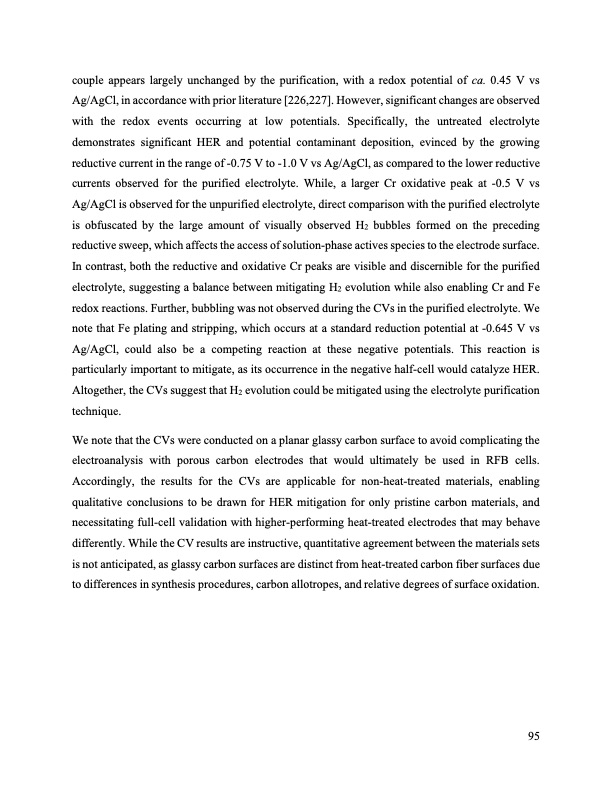
PDF Publication Title:
Text from PDF Page: 095
couple appears largely unchanged by the purification, with a redox potential of ca. 0.45 V vs Ag/AgCl, in accordance with prior literature [226,227]. However, significant changes are observed with the redox events occurring at low potentials. Specifically, the untreated electrolyte demonstrates significant HER and potential contaminant deposition, evinced by the growing reductive current in the range of -0.75 V to -1.0 V vs Ag/AgCl, as compared to the lower reductive currents observed for the purified electrolyte. While, a larger Cr oxidative peak at -0.5 V vs Ag/AgCl is observed for the unpurified electrolyte, direct comparison with the purified electrolyte is obfuscated by the large amount of visually observed H2 bubbles formed on the preceding reductive sweep, which affects the access of solution-phase actives species to the electrode surface. In contrast, both the reductive and oxidative Cr peaks are visible and discernible for the purified electrolyte, suggesting a balance between mitigating H2 evolution while also enabling Cr and Fe redox reactions. Further, bubbling was not observed during the CVs in the purified electrolyte. We note that Fe plating and stripping, which occurs at a standard reduction potential at -0.645 V vs Ag/AgCl, could also be a competing reaction at these negative potentials. This reaction is particularly important to mitigate, as its occurrence in the negative half-cell would catalyze HER. Altogether, the CVs suggest that H2 evolution could be mitigated using the electrolyte purification technique. We note that the CVs were conducted on a planar glassy carbon surface to avoid complicating the electroanalysis with porous carbon electrodes that would ultimately be used in RFB cells. Accordingly, the results for the CVs are applicable for non-heat-treated materials, enabling qualitative conclusions to be drawn for HER mitigation for only pristine carbon materials, and necessitating full-cell validation with higher-performing heat-treated electrodes that may behave differently. While the CV results are instructive, quantitative agreement between the materials sets is not anticipated, as glassy carbon surfaces are distinct from heat-treated carbon fiber surfaces due to differences in synthesis procedures, carbon allotropes, and relative degrees of surface oxidation. 95PDF Image | Bringing Redox Flow Batteries to the Grid

PDF Search Title:
Bringing Redox Flow Batteries to the GridOriginal File Name Searched:
Rodby-krodby-phd-chemE-2022-thesis.pdfDIY PDF Search: Google It | Yahoo | Bing
Salgenx Redox Flow Battery Technology: Salt water flow battery technology with low cost and great energy density that can be used for power storage and thermal storage. Let us de-risk your production using our license. Our aqueous flow battery is less cost than Tesla Megapack and available faster. Redox flow battery. No membrane needed like with Vanadium, or Bromine. Salgenx flow battery
| CONTACT TEL: 608-238-6001 Email: greg@salgenx.com | RSS | AMP |